
Drip irrigation management
How to manage your drip irrigation system
Irrigation control systems are used to ensure a desired level of moisture is maintained for the plants with or without the presence of a human operator. Beyond the basic components of a drip system, there are ways to manage the system as a whole. These include valves and timers. Options vary from simpler and less expensive battery-operated hose bib assemblies controlling a single hydrozone to larger systems that include an irrigation controller running multiple valves and connected to home electricity.
Battery-operated hose bib assembly:
This assembly attaches drip irrigation to a hose bib (outdoor faucet) and waters one hydrozone.
The set of components to create this “hose bib assembly” requires:
- a battery-operated timer with an internal valve that runs the system automatically after it is programmed. Adjust throughout the irrigation season.
- an anti-siphon device (vacuum breaker) to prevent irrigation water from the garden accidentally entering the potable water in the house if there is a change in water pressure
- a filter to prevent particulate matter from clogging emitters
- a pressure regulator to reduce the water pressure into the 20-40 psi range
- hose-end to drip fitting
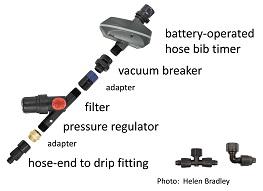 |
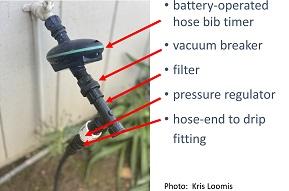 |
There are a number of interchangeable components. Ask at an irrigation store for their version of these components. Take the Garden Sense handout on hose bib assemblies to the irrigation store.
Hose bib timers can be adjusted monthly with the use of seasonal adjustments.
Irrigation controller and valves: An irrigation controller is a device that uses programmed information to turn one or more irrigation valves on and off through electrical connections. Irrigation valves are used to create various watering zones in an irrigation system.
Irrigation controller: An irrigation controller is a device to operate automatic irrigation systems. Most controllers require connecting electrical wiring from the controller to each valve. Most controllers have a means of setting the frequency of irrigation, the start time, and the duration of watering.
Understanding Your Irrigation System (City of Santa Rosa)
 |
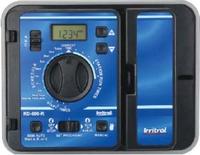 |
|---|---|
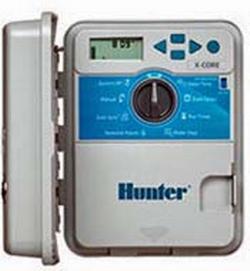 |
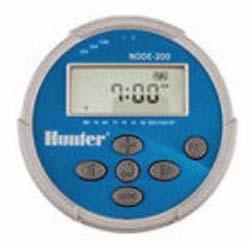 |
Irrigation controllers often have features that allow irrigation schedules to be adjusted to respond to the weather. These features include water budgeting, rain sensors and weather stations.
|
The water budgeting feature allows for the incorporation of seasonal adjustments, a feature that reduces or increases run times for all zones based on a percentage of the programmed time (Example: 10-minute run time at 50% would instead run 5 minutes). |
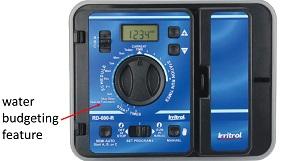 |
Click here for seasonal adjustments for Sonoma County.
A rain sensor communicates with the irrigation controller about the level of rainfall. If enough rain has fallen, the sensors let the controller know to turn off the system for some period of time.A weather station is a device connected to an irrigation controller that uses historical and current weather information to modify the irrigation schedule in response to temperature, sun exposure, rain. It also uses multiple years of stored weather data for a geographical area.
Smart Irrigation Controllers:
These controllers connect to the internet (Wi-Fi and/or phone) to access information from remote weather stations, using weather information and current site conditions to tailor the irrigation system daily. A rain sensor can also be added.
Smart Irrigation Controllers (UC ANR)
Valves
An irrigation valve opens and closes in response to an electronic message from an irrigation controller. Irrigation valves are used to create various watering zones (hydrozones) in an irrigation system.
 |
An anti-siphon valve includes a backflow prevention component so that dirty water does not contaminate house potable water. |
| In-ground valves require a separate backflow prevention device. |  |
The topics outlined below will help you install a drip system.
- Drip irrigation vs other irrigation methods
- How to get started
- Drip irrigation management
- Key considerations when implementing a drip system
- Drip irrigation basics
- Drip irrigation in different landscape situations
- Determining how much water to apply and how often
- Maintaining an irrigation system
- How to get help







